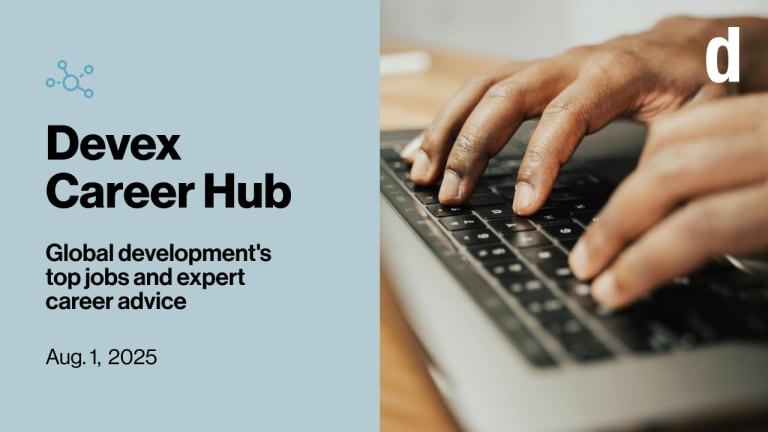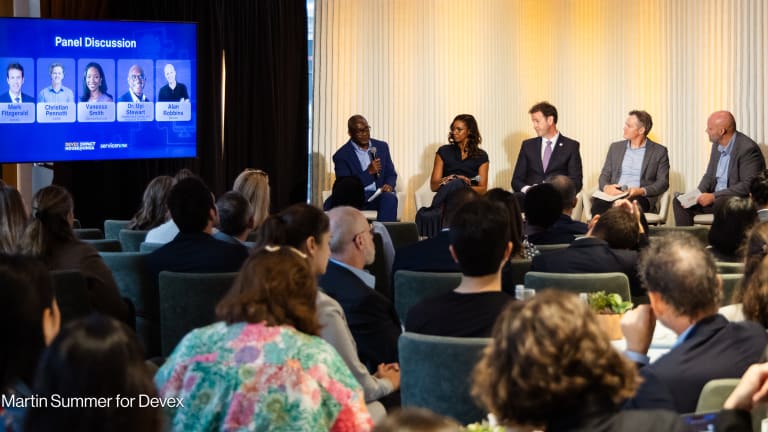
Artificial intelligence, or AI, is moving rapidly from predictive tools to agentic systems that act with greater autonomy — able not only to respond to questions, but also to execute tasks and make decisions. Undoubtedly, agentic AI could be transformational for the private sector, holding the power to reshape how businesses operate. At the same time, it has significant potential to accelerate progress toward the Sustainable Development Goals, or SDGs.
For governments, businesses, communities, and the broader development sector, ensuring that the global workforce is ready to adapt is a leading concern. According to Salesforce’s Global AI Readiness Index, human capital mobilization remains the most significant barrier to AI adoption, especially in emerging markets.
“We know AI and agents, it's completely changing the way that we work. It's about reskilling our people to make sure they understand the skills needed to succeed in this era,” Alexandra Legend Siegel, senior vice president and chief equality and engagement officer at Salesforce, said during a high-level event held on the sidelines of the 80th United Nations General Assembly, hosted by Devex in partnership with Salesforce.
Through panel and workshop discussions, policymakers, business leaders, and development practitioners underscored both the risks of widening inequality and the opportunities for inclusive growth if skills, partnerships, and governance can keep pace with innovation.
Trust as a foundation for adaptation
A recurring theme throughout the sessions was the lack of trust in AI technology, which has been a significant barrier to its adoption, not only among workers but also in the communities they serve.
Dr. Ricardo Baptista Leite, CEO of HealthAI, noted past digital transformations in the global health space that resulted in heavier workloads for frontline employees rather than increased efficiency — fueling skepticism toward new tools. Workers also want to understand how AI systems are making decisions and what safeguards exist to prevent bias or error.
To build trust, workers need to see AI integrated in ways that simplify their daily tasks, rather than disrupt them. “There is a need to integrate whatever AI technologies and solutions are developed within the current workflows, so it's not a major transformation; [rather], it just comes naturally [and] is embedded in day-to-day life,” Baptista Leite said.
Co-creation was emphasized as essential to the success of this integration: When systems are developed with input from the people who will ultimately use them, they are far more likely to be embraced.
“Include the groups that you want in the work from the beginning, and co-design with them moving forward,” John Harnisher, head of education research at DataKind, suggested.
Speakers highlighted the need to equip workers with the skills and confidence to use AI effectively, turning apprehension into engagement — and allowing professionals to identify tangible benefits in productivity, safety, or reduced administrative burden.
“The best way to bridge the fear gap is to start using the technology,” Siegel said.
Building the pipeline for an AI-ready workforce
Alongside reskilling existing workers, participants stressed the importance of preparing the next generation with the digital skills needed to thrive in an AI-driven economy. Liesbet Steer described this as building a “pipeline of people” — ensuring that education systems at every level produce graduates who can adapt to shifting labor markets and participate meaningfully in the digital economy.
Currently, “education systems are not producing what we need — the skills we need in the labor market,” Steer said. Despite progress, she noted that roughly half of the world’s youth still lack basic proficiency in reading and mathematics, while digital skills shortages are widespread even in advanced economies.
The fact that many countries still rely on outdated curricula that are misaligned with labor market demand, while fewer than 1% of global data centers are located in Africa, despite being home to 18% of the world’s population. This underscores the deep inequalities in digital infrastructure. Emerging markets are often “data rich but information poor,” unable to turn raw data into actionable insights without stronger governance and systems, according to Uyi Stewart, vice president of inclusive innovation and analytics at Mastercard Center for Inclusive Growth.
However, participants also highlighted the potential of AI itself to help bridge this gap. Personalized learning tools can tailor instruction to a child’s pace, language, and context, helping students who might otherwise be left behind.
Idah Pswarayi-Riddihough, global director in the digital vice presidency at the World Bank Group, shared an example of schoolchildren in Nigeria using generative AI tools to improve curriculum retention after only a few weeks of use.
“The improvement in the learning was phenomenal, because ChatGPT is not going to teach you at a pace that is different from the one that you can learn at. So it individualizes the whole learning process. To me, this is where the future is actually going,” Pswarayi-Riddihough said.
A holistic and human-centric approach
Throughout the session, additional recommendations were proposed to help accelerate AI adoption while mitigating associated risks. These included structuring equitable public-private partnerships, modular credentialing systems that move beyond traditional degrees, and incorporating human-centric design principles.
In this vein, Lydia Logan, who leads IBM’s education and workforce development initiatives, stressed the need to include a diverse group of those who will be using it in product development, “which can help avoid 'baking in’ existing bias as we develop new models.”
The wide range of solutions offered underscored the need for a holistic approach to AI development and adoption. Steer outlined a framework that recognizes this, which she referred to as the “three I’s”: intentionality, innovation, and investment. This approach puts skills at the center of transition strategies while also rethinking how education and training accreditation is delivered, as well as how funding is spent. “Countries and businesses need to become more intentional and incorporate the impact of jobs and skills into transition strategies,” Steer said.
While the need to train and learn new technical skills is critical, translating these into impact will require adaptability, problem-solving, and continuous learning — human skills that may ultimately prove to be the most important of all.
“I think it's absolutely critical to build human capital in the future of AI,” Harnisher said. As we learn new skills, “what's really most important in this is to make sure that we are valuing those skills that stay with us — things like cooperation, things like connectivity, things that are about humans and human trust moving forward.”








